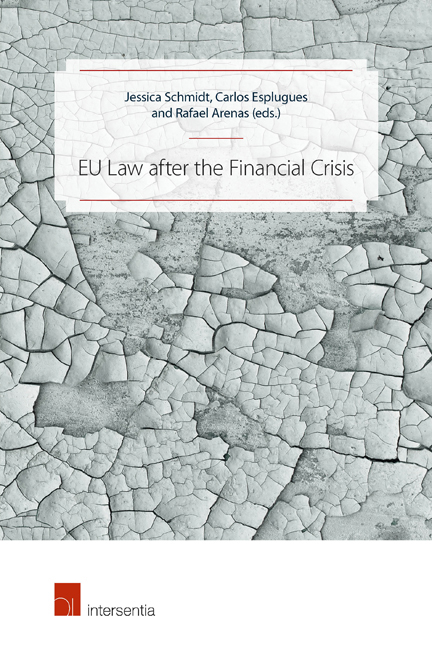Book contents
- Frontmatter
- Contents
- List of Abbreviations
- List of Authors
- Introduction
- PART I RESCUE MECHANISMS AND MONETARY POLICY
- PART II THE IMPACT OF THE FINANCIAL CRISIS ON THE BANKING SECTOR AND CAPITAL MARKETS
- Financial Crisis and European Company and Capital Markets Law
- CoCo Bonds as a Means of Reducing Systemic Risk and their Role within New Regulatory Regimes
- Is EU Financial Law Overly Complex?
- PART III THE FINANCIAL CRISIS AND TAX LAW
- PART IV THE FINANCIAL CRISIS, CONSUMERS AND CONSUMER LAW
- PART V THE FINANCIAL CRISIS AND COMPETITION LAW
- PART VI THE FINANCIAL CRISIS, RESTRUCTURING AND INSOLVENCY LAW
- PART VII THE SOCIAL DIMENSION OF THE FINANCIAL CRISIS AND EU CITIZENSHIP
- PART VIII REFLECTIONS ON THE IMPACT OF THE FINANCIAL CRISIS ON THE GENERAL EUROPEAN LEGAL FRAMEWORK AND THE FUNDAMENTAL “EUROPEAN IDEA”
Financial Crisis and European Company and Capital Markets Law
from PART II - THE IMPACT OF THE FINANCIAL CRISIS ON THE BANKING SECTOR AND CAPITAL MARKETS
Published online by Cambridge University Press: 13 December 2017
- Frontmatter
- Contents
- List of Abbreviations
- List of Authors
- Introduction
- PART I RESCUE MECHANISMS AND MONETARY POLICY
- PART II THE IMPACT OF THE FINANCIAL CRISIS ON THE BANKING SECTOR AND CAPITAL MARKETS
- Financial Crisis and European Company and Capital Markets Law
- CoCo Bonds as a Means of Reducing Systemic Risk and their Role within New Regulatory Regimes
- Is EU Financial Law Overly Complex?
- PART III THE FINANCIAL CRISIS AND TAX LAW
- PART IV THE FINANCIAL CRISIS, CONSUMERS AND CONSUMER LAW
- PART V THE FINANCIAL CRISIS AND COMPETITION LAW
- PART VI THE FINANCIAL CRISIS, RESTRUCTURING AND INSOLVENCY LAW
- PART VII THE SOCIAL DIMENSION OF THE FINANCIAL CRISIS AND EU CITIZENSHIP
- PART VIII REFLECTIONS ON THE IMPACT OF THE FINANCIAL CRISIS ON THE GENERAL EUROPEAN LEGAL FRAMEWORK AND THE FUNDAMENTAL “EUROPEAN IDEA”
Summary
The epicentre of the financial crisis earthquake that shook the globe in 2007/08 was located on the financial markets.
Hence, it is hardly surprising that capital markets law almost immediately became the focus of legislative activity, which ultimately resulted in downright seismic reforms of the EU financial markets architecture. But the financial crisis also had a profound impact on legislative action in the closely related field of EU company law.
This chapter provides an overview of the most important reform measures and their practical and conceptual ramifications.
FINANCIAL CRISIS AND EUROPEAN CAPITAL MARKETS LAW
As already indicated, the financial crisis had a truly seismic impact on European capital markets law, shaking it down to its very foundations.
The “earthquake” abruptly roused European capital markets law from a state of relative tranquillity. After the Financial Services Action Plan of 1999 had been fully implemented by 2005, the Commission's leitmotiv had actually been (dynamic) consolidation rather than new reforms. But the financial crisis earthquake suddenly put the European legislator under enormous pressure to act in order to guarantee the functioning of the European financial markets and to restore investor confidence.
EMERGENCY MEASURES
In the immediate aftermath of the crisis, the ECB, the Commission and national governments undertook a variety of emergency measures, including substantial injections of public money into the banking sector. But it was immediately apparent that coordinated action was necessary: Hence, in October 2008, the Eurozone countries issued a “Declaration on a concerted European Action Plan” and the Council established a “financial crisis cell” in order to enable speedy and effective action.
COMPREHENSIVE REFORM OF THE EU FINANCIAL MARKETS ARCHITECTURE
However, it was also clear that these emergency measures were only stopgap solutions and that it was imperative to tackle the structural problems and deficits of European financial markets regulation. Thus, by the end of 2008, the European Commission started preparations for a comprehensive reform both of the supervisory system and the substantive legal framework. In spring 2009, it outlined a roadmap and the first legislative proposals followed in the autumn of 2009.
- Type
- Chapter
- Information
- EU Law after the Financial Crisis , pp. 33 - 46Publisher: IntersentiaPrint publication year: 2016



